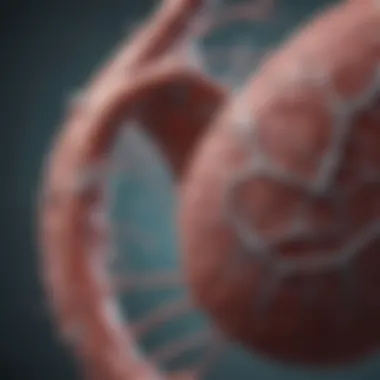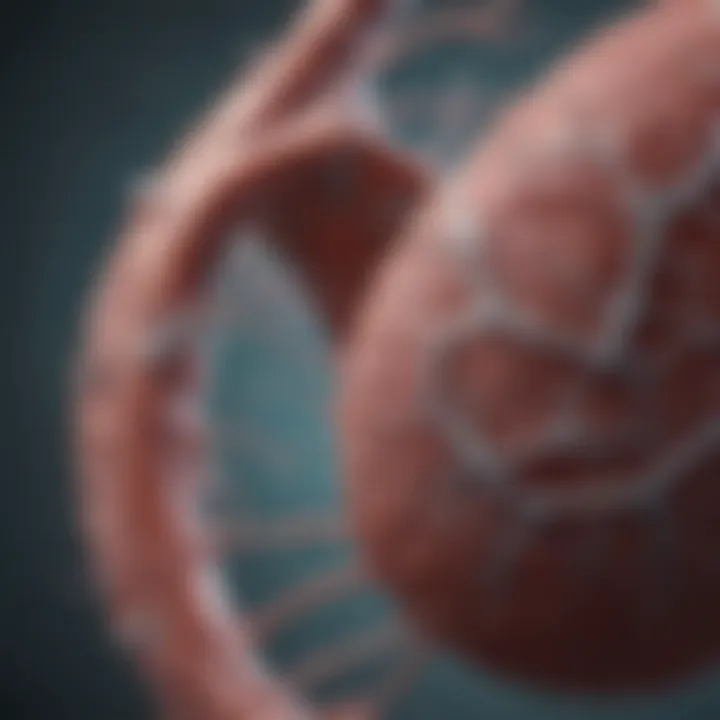Exploring the PKD Gene: Insights and Advances


Intro
Polycystic kidney disease (PKD) emerges as a critical condition impacting a significant swath of the population. A key player in this disease is the PKD gene, intricately woven into the fabric of kidney function and overall health. Understanding this gene is not merely an academic exercise; it holds profound implications for those affected and paves the way for potential treatment avenues. This article seeks to pull back the curtain on the PKD gene, exploring its intricate variations and how they relate to the clinical realities of PKD.
As researchers continue to unearth the nuances of the PKD gene, not only are they shedding light on the condition, but the advancements in gene therapy spark optimism for the future. By gleaning insights from recent findings, we aim to present a cohesive understanding of this pivotal gene; a journey through discovery and innovation awaits.
Research Overview
Summary of Key Findings
Research surrounding the PKD gene has markedly evolved. Recent studies show that mutations in the PKD1 and PKD2 genes are responsible for the two most common forms of PKD. These genes essentially disrupt the delicate balance of fluid retention and cellular growth in the kidneys, leading to the formation of cysts.
Key findings include:
- Identification of genetic variations linked to the severity and progression of the disease.
- Investigations into the role of vascular endothelial growth factor (VEGF) as a pivotal marker in managing PKD.
- Development of animal models to better understand PKD pathology and test therapeutic strategies.
Importance of the Research in its Respective Field
This research is crucial not only for understanding the underlying mechanisms of PKD but also for informing clinical practices. It aids healthcare professionals in tailoring treatment strategies based on genetic profiles, thereby fostering more personalized medicine. Furthermore, these findings hold potential for the development of novel therapies that could alleviate or even prevent the progression of the disease.
Methodology
Description of the Experimental or Analytical Methods Used
The research in the domain of PKD often employs a range of methodologies. Genetic sequencing techniques are predominant, allowing for the identification of specific mutations in the PKD genes. Additionally, longitudinal studies monitor the progression of PKD over time in patient cohorts, providing insights into how different mutations impact the disease.
Sampling Criteria and Data Collection Techniques
Participants in these studies are typically selected based on clinical diagnosis confirmed through imaging techniques, such as ultrasound or MRI. Data collection typically includes:
- Collecting blood samples for genetic analysis.
- Gathering detailed patient histories to evaluate the onset and progression of symptoms.
- Conducting regular follow-ups to assess kidney function and overall health.
Through systematic research and robust methodologies, the scientific community continues to deepen its understanding of the PKD gene, laying the groundwork for future innovations in treatment and care.
"Understanding the genetics behind PKD opens doors to personalized treatment approaches, potentially revolutionizing patient outcomes."
As we delve further into the nuances of the PKD gene, we will explore its role in kidney function, the implications for treatment, and ongoing research ripe with promise. Starting from fundamental genetics to cutting-edge therapies, the journey highlights the significance of the PKD gene in health and disease.
Prelims to the PKD Gene
The exploration of the PKD gene is essential for understanding the complexities of polycystic kidney disease (PKD). This genetic condition greatly affects millions of individuals globally, shaping their health and well-being. By delving into the underlying genetics of PKD, we can unravel vital insights that inform both current and future treatment strategies. Moreover, a thorough grasp of the PKD gene leads to more effective diagnostic tools, paving the way for personalized medicine that caters to individual genetic profiles.
Overview of PKD and Its Genetic Basis
Polycystic kidney disease is primarily characterized by the formation of numerous cysts in the kidneys, which can lead to renal dysfunction over time. The involvement of the PKD gene is a critical piece of this puzzle. Genetic analysis has revealed that variations in the PKD1 and PKD2 genes are responsible for the majority of cases. These genes located on chromosomes 16 and 4 respectively, encode proteins crucial for regulating kidney cell function and maintaining fluid balance.
The hereditary nature of PKD raises significant concerns; it can be inherited in an autosomal dominant or autosomal recessive manner. In autosomal dominant PKD, for instance, only one copy of the mutant gene from an affected parent suffices to cause the disease, often leading to symptoms noticeable in adulthood. Conversely, autosomal recessive PKD more commonly manifests in infancy or early childhood, necessitating heightened awareness for early interventions.
Research into the genetic underpinnings of PKD not only underscores the need for precautionary measures in families with a history of the disease but also highlights opportunities for gene-targeted therapies. For example, emerging studies focus on how gene editing might correct faulty genes, potentially restoring normal function to renal cells. As we continue to unveil the intricacies of the PKD gene, understanding its implications becomes vital for both improving patient outcomes and advancing scientific research.
"The insights gained from the study of the PKD gene not only hold promise for better treatment but also foster hope for innovative approaches in managing polycystic kidney disease."
In summary, the PKD gene serves as a cornerstone in our understanding of PKD and its clinical implications. As we journey through the nuances of this subject, it is clear that expanding our knowledge of genetic factors is crucial in confronting the challenges posed by this chronic condition.
Genetic Structure of the PKD Gene
The genetic structure of the PKD gene serves as the backbone for understanding its role in polycystic kidney disease (PKD). By exploring this structure, we can identify how mutations affect gene functionality, ultimately leading to disease manifestations. Studying the PKD gene's format and features helps in recognizing potential therapeutic targets and enhances our overall grasp of the disease's evolution in both genetic research and clinical practices.
Chromosomal Location and Composition
The PKD gene is primarily located on chromosome 16 (specifically the PKD1 gene) and chromosome 4 (the PKD2 gene). These locations are crucial since they hold the responsibility for coding proteins essential for kidney function. The PKD1 gene, for instance, encodes polycystin-1, which is involved in cellular signaling and tissue development. Mutations here are predominantly linked to the autosomal dominant form of PKD, often leading to severe health consequences.
The genomic structure of the PKD gene includes a significant number of exons and introns, which contributes to its size and complexity. These exons are crucial as they dictate the protein's overall functionality. Notably, there are around 46 exons in PKD1 that span more than 50 kb of DNA. This expansive structure allows for intricate mechanisms that regulate protein synthesis.
To delve deeper into the gene’s composition:
- Exons: These segments are expressed and translated into proteins.
- Introns: Though they don't code for proteins, these regions play a vital role in gene regulation and alternative splicing.
Understanding where the PKD gene resides in the genome aids researchers in pinpointing mutations more effectively and developing targeted therapies. Genetic mapping also helps in assessing familial risk, as knowledge of inheritance patterns is essential for potential interventions.
Alternative Splicing Variants


Alternative splicing introduces further complexity to the PKD gene's function. Essentially, this biological process allows a single gene to code for multiple proteins by generating different mRNA transcripts from the same gene segment. This phenomenon is particularly pertinent in the PKD context since various splicing variants of polycystin-1 and polycystin-2 are known to exist, each potentially playing unique roles in kidney physiology.
- Polycystin-1: The predominant variant that is essential in maintaining kidney tubular structure and function.
- Polycystin-2: Another critical variant that engages in calcium signaling pathways, affecting cellular processes.
The existence of these splicing variants means that even a minor mutation in the PKD gene can lead to different disease manifestations or severity. Additionally, it poses challenges for genetic testing and diagnosis, as each variant might require a different approach for identification and understanding.
Moreover, ongoing research is striving to unravel the implications of these variants in treatment strategies. Enhancing our knowledge of alternative splicing variants can lead to better diagnostic criteria and potential therapies for those carrying PKD gene mutations.
As we further our understanding of the genetic structure of the PKD gene, we uncover layers of complexity that influence prognosis, treatment approaches, and patient care strategies, pointing a clear path towards more personalized interventions in PKD management.
Types of Polycystic Kidney Disease
Understanding the types of polycystic kidney disease is essential in grasping the broader implications of the PKD gene, especially regarding patient care and treatment pathways. PKD, a genetic disorder characterized by the growth of numerous cysts in the kidneys, primarily segregates into two forms: Autosomal Dominant Polycystic Kidney Disease (ADPKD) and Autosomal Recessive Polycystic Kidney Disease (ARPKD). Each type presents uniquely, bearing distinct clinical features, prognosis, and genetic inheritance patterns.
Recognizing these differences not only aids healthcare providers in tailoring interventions but also enhances patient awareness about their condition. With a more precise understanding, individuals can engage in proactive management of their health.
Autosomal Dominant Polycystic Kidney Disease
ADPKD is the more prevalent form of polycystic kidney disease, impacting roughly one in 400 to 1,000 individuals worldwide. As the name suggests, this disorder follows an autosomal dominant inheritance pattern, meaning that an affected individual has a 50% chance of passing the gene mutation to their offspring. The mutations primarily occur in the PKD1 and PKD2 genes, with PKD1 being associated with more severe disease progression.
The clinical manifestations of ADPKD typically become apparent in adulthood, with symptoms often emerging between the ages of 30 and 50. Patients may experience a range of symptoms, including:
- Hypertension: This is often one of the first signs and can develop before kidney problems are evident.
- Abdominal or flank pain: As cysts enlarge, they can cause discomfort in the abdomen or sides.
- Hematuria: Blood in urine can occur due to ruptured cysts or other complications.
- Kidney stones: The formation of stones is more prevalent in individuals with ADPKD due to changes in urinary composition.
Importantly, complications can extend beyond kidney health. Individuals with ADPKD may be at increased risk for liver cysts, pancreatic cysts, and cardiovascular issues, including aneurysms. Regular monitoring through imaging and biochemical tests becomes crucial to manage these risks effectively.
Autosomal Recessive Polycystic Kidney Disease
On the flip side, ARPKD is a rarer form, occurring in about one in 20,000 live births. This condition is characterized by cysts forming in the kidneys and liver, with significant implications for neonatal and infant health. Unlike ADPKD, ARPKD follows an autosomal recessive pattern, meaning that an individual must inherit two copies of the mutated gene for the disease to manifest, typically both from carrier parents.
Symptoms of ARPKD usually present in the early stages of life, often detected during fetal ultrasounds or shortly after birth. Common signs include:
- Enlarged kidneys: Due to the proliferation of cysts, kidneys appear much larger than normal at birth.
- Respiratory distress: This complication can arise from abdominal distension due to enlarged kidneys, which may compress the diaphragm.
- Liver involvement: Fibrocystic disease can lead to portal hypertension, significantly impacting liver function.
The prognosis for ARPKD varies. Some children may not survive past infancy, while others can live into adulthood with ongoing medical management. Understanding these nuances is critical for families navigating the complexities of diagnosis and care solutions.
"Knowledge of PKD entails understanding the implications of both its dominant and recessive forms, shaping treatment approaches and patient outcomes."
In summary, recognizing the distinctions between ADPKD and ARPKD is crucial for effective diagnosis and management. Each type demands a tailored approach, from genetic counseling to routine assessment of complications that may arise throughout the patient's life, underlining the importance of the PKD gene in understanding these conditions.
Pathophysiology of PKD
Understanding the pathophysiology of Polycystic Kidney Disease (PKD) is essential for grasping how this genetic condition manifests and progresses. The mechanisms at play not only elucidate the formation of kidney cysts but also frame the broader implications of PKD on renal operations and overall patient health. Within this framework, health professionals can better diagnose, treat, and advocate for patients suffering from PKD.
Mechanisms of Cyst Formation
At the heart of PKD pathophysiology is the formation of cysts—an unusual outpouring of fluid-filled sacs within the kidneys. But how do these cysts come about? A primary factor involves mutations within the PKD genes, mainly PKD1 and PKD2. These genes code for proteins that play crucial roles in cellular signaling and structure. When these proteins are dysfunctional due to genetic mutations, the normal regulation of kidney cells breaks down.
Fluid builds up, leading to cyst formation. Here’s a simplified look into the cellular cascade:
- Cellular signal disruption: The mutations prevent proper communication between cells, leading to uncontrolled growth.
- Fluid accumulation: Inflammatory responses alongside cellular communication failure results in excessive fluid secretion by the affected cells.
- Cyst expansion: Over time, cysts grow larger, encroaching upon normal kidney tissue and further complicating the renal landscape.
The situation can be like a leaky faucet. At the outset, a minor drip may seem inconsequential, yet over time, the accumulation of water can cause significant structural damage. Similarly, cysts may be small at first, but they can expand unchecked, leading to extensive disruption of kidney function.
Impact on Kidney Function
The escalating size and number of cysts aren't just a matter of discomfort; they fundamentally alter kidney function. As these cysts proliferate, they exert pressure on surrounding healthy tissue, affecting the kidneys' ability to filter blood and produce urine—a condition that may escalate to chronic kidney disease.
Here’s how these changes manifest:
- Diminished nephron function: With more cysts, fewer healthy nephrons remain. This leads to impaired filtration.
- Progressive renal failure: After years, the cumulative impact often results in end-stage renal disease, necessitating dialysis or transplantation.
- Systemic implications: The effects can ripple outwards, influencing systemic blood pressure and may even contribute to metabolic disorders, given the kidneys’ role in various bodily functions.
"The interplay of cyst formation and kidney function illustrates how intricately connected our body systems are; one small mutation can lead to significant health challenges."
Overall, the pathophysiology of PKD isn't just a sequence of biological events—it's a critical insight into the struggles that those with this disease face daily. The relationships between cysts and kidney function is foundational for understanding treatment options and their effectiveness, paving the way for advancements in both diagnostics and therapies.
Genetic Testing and Diagnosis
Genetic testing stands as a pivotal element in the management of polycystic kidney disease (PKD), linking genetic understanding with clinical practice. As we delve into this topic, it's vital to emphasize how identifying PKD gene mutations not only aids in diagnosing individuals but also fine-tunes treatment strategies and prognostic understanding. Embracing the genetic nuances of PKD provides significant insights into the affected person's health trajectory.
Methods for Identifying PKD Gene Mutations
When it comes to pinpointing PKD gene mutations, a variety of methods are employed, each with its benefits and drawbacks. Here are some of the prominent techniques in use:


- Next-Generation Sequencing (NGS): This powerful method allows for comprehensive screening of the entire PKD gene, identifying both large deletions and tiny mutations. NGS has revolutionized our ability to detect variants that traditional methods might miss.
- Sanger Sequencing: Though considered more traditional, Sanger sequencing remains reliable for confirming results found by NGS. It’s precise for targeting specific mutations that have been previously identified in families.
- Multiplex Ligation-dependent Probe Amplification (MLPA): This technique is effective in detecting gene deletions or duplications. It serves as an auxiliary method alongside NGS, especially for patients with a strong family history of PKD but no clear pathogenic variants.
- Panels Testing: Genetic testing panels focusing on renal diseases can provide insight into multiple kidney-related conditions that might mimic PKD. These panels help healthcare providers make informed decisions regarding patient care.
Using a combination of these methods maximizes the chances of accurate diagnosis and influences treatment options based on the specific genetic profile of the patient.
Challenges in Genetic Testing
Despite the advancements, genetic testing for PKD comes with its own set of challenges that can complicate the diagnostic process. Some notable ones include:
- Variability of Mutations: The sheer number and variability of mutations associated with the PKD gene complicate detection. Some mutations are less understood, leading to ambiguous test results that can be hard to interpret.
- Limited Access to Testing: In certain regions, access to advanced genetic testing technologies can be restricted due to healthcare disparities, geographic limitations, or financial constraints, leaving affected individuals without vital diagnostic tools.
- Psychosocial Implications: The results of genetic testing can create emotional turmoil. Not all patients are prepared for the knowledge of having a hereditary disease, and some may feel anxiety about the implications for their family members.
- Mutation Unsurety: There's also a phenomenon known as the variant of uncertain significance (VUS), where a mutation is detected, but its role in causing disease remains questionable. This can lead to uncertainty in management and follow-up care.
"Understanding the challenges in genetic testing allows us to build a more effective framework for patient diagnosis and treatment, bridging gaps in current methodologies."
Addressing these challenges is crucial for enhancing the capabilities of genetic testing in PKD. This can involve raising awareness, improving access to resources, and ensuring that healthcare professionals are prepared to navigate the complexities of genetic results. The journey through genetic testing not only signifies a step towards comprehension but also illuminates the path ahead in managing PKD.
Clinical Manifestations of PKD
Understanding the clinical manifestations of polycystic kidney disease (PKD) is vital for comprehending the broader implications of the PKD gene. This section highlights the significance of early recognition of symptoms, the potential complications that arise from the disease, and the necessary evaluations and monitoring that can help manage its progression. Better awareness can lead to improved patient outcomes and more effective strategies for care.
Symptoms and Complications
The symptoms of PKD often do not present until adulthood, which can be problematic. This late onset means that individuals might live for years without knowing they carry the PKD gene, making awareness crucial. Here are some common symptoms:
- Abdominal or flank pain: These pains are usually caused by cyst formation and can be sporadic or persistent.
- High blood pressure: This is a significant symptom, often occurring early in the disease's course and can worsen with time.
- Cyst infection: Individuals may experience fever, pain, and urinary symptoms if a cyst becomes infected.
- Kidney stones: Those with PKD are at higher risk for developing kidney stones, causing severe discomfort.
- Hematuria: The presence of blood in urine can indicate kidney complications.
Complications of PKD arise from the gradual decline in kidney function and can lead to more severe health issues. One of the most serious outcomes is end-stage renal disease (ESRD), necessitating dialysis or transplant. Another concern is cardiovascular complications due to the prolonged presence of high blood pressure. Monitoring these symptoms is essential to manage health effectively and to make informed decisions about treatment options.
"Early detection of symptoms can significantly influence management strategies and treatment outcomes for PKD patients."
Evaluation and Monitoring
Evaluating and monitoring individuals with PKD is quite essential for understanding the disease's progression and applying the necessary interventions. Regular check-ups typically involve:
- Kidney imaging tests: Ultrasounds or MRIs are used to assess cyst size and kidney function.
- Blood tests: These help in monitoring kidney function, electrolytes, and overall health.
- Routine blood pressure checks: Given the close relationship between PKD and hypertension, regular monitoring is crucial.
- Urinalysis: Inspection of urine can identify any abnormalities early, such as blood, protein, or signs of infection.
A proactive approach to evaluation allows healthcare providers to tailor treatments based on how the disease manifests in each patient. The goal is to not only treat existing complications but also to anticipate future challenges, ensuring the best quality of life possible for individuals living with PKD. This multidisciplinary approach often involves nephrologists, dietitians, and other specialists to create a comprehensive care regimen.
Current Treatments for PKD
Understanding the current treatments for polycystic kidney disease (PKD) is essential for individuals affected by the condition, as well as healthcare professionals and researchers dedicated to enhancing quality of life for patients. Given that PKD is a progressive disorder with significant variances in patient presentation, recognizing the available therapeutic options can help in managing symptoms, preventing complications, and potentially slowing disease progression.
This section delves into both pharmacological approaches and surgical interventions that constitute the current treatment landscape for PKD. The focus will remain on how each option aids in alleviating symptoms and improving patient outcomes while highlighting considerations that must be taken into account for effective treatment strategies.
Pharmacological Approaches
Pharmacological treatment for PKD encompasses a multitude of medication types aimed at addressing the various symptoms associated with the disease. Some significant strategies include:
- Blood Pressure Management: Hypertension is commonly seen among PKD patients, often leading to kidney damage if left untreated. Angiotensin-converting enzyme (ACE) inhibitors, like lisinopril, are frequently prescribed to keep blood pressure in check. Not only do these medications effectively reduce blood pressure, but they also provide kidney protection by reducing the strain on renal blood vessels.
- Pain Management: As cysts grow, they can cause considerable discomfort. Over-the-counter pain relievers such as ibuprofen or acetaminophen are typically utilized. In more severe cases, stronger opioid medications may be necessary. It is vital to approach pain management carefully, considering potential impacts on kidney function.
- Cyst-Reducing Agents: Recent studies have proposed the use of tolvaptan, a vasopressin receptor antagonist. This medication has shown promise in slowing the progression of kidney enlargement and preserving renal function in patients with autosomal dominant polycystic kidney disease (ADPKD). While effective, it is critical to monitor liver function, as tolvaptan can induce liver enzyme elevations.
"Chronic management of PKD often involves a multidisciplinary approach, integrating both pharmacological strategies and lifestyle changes for optimal outcomes."
In summary, pharmacological management forms a cornerstone of treating PKD. Personalized treatment plans tailored to individual symptoms and progression can significantly improve the quality of life.
Surgical Interventions
Surgical options for PKD are generally considered when conservative management through medications does not yield satisfactory results or when complications arise. There are a few key surgical interventions relevant to PKD patients:
- Cyst Aspiration: For patients suffering from large, uncomfortable cysts, a cyst aspiration may provide short-term relief. This procedure involves withdrawing the fluid from a cyst, which can help alleviate pain and pressure. However, cysts often refill, making this a temporary fix rather than a long-term solution.
- Laparoscopic Surgery: In cases of recurrent infections or significant size-related problems, laparoscopic surgery can be employed to remove large cysts or multiple cysts. This minimally invasive approach generally allows for quicker recovery times and less postoperative pain compared to open surgery.
- Kidney Transplantation: In severe cases of PKD, where renal function is critically compromised, kidney transplantation might be necessary. Transplantation offers a path to restore kidney function, but it presents challenges, including the need for life-long immunosuppression to prevent organ rejection.
In summary, while surgical interventions are not the first line of treatment for most PKD patients, they become crucial when conservative methods no longer suffice. These procedures can substantially improve pain, protect remaining kidney function, and enhance overall well-being. Understanding these treatments is vital for ongoing patient management and paves the way for future clinical insights.
Emerging Therapies and Clinical Trials
The exploration of emerging therapies and clinical trials in the context of polycystic kidney disease (PKD) is vital for a number of reasons. First and foremost, it addresses the pressing need for more effective treatments, given the limitations of current pharmacological and surgical approaches. As our understanding of the PKD gene advances, so too does the promise of novel therapies tailored to the unique genetic and phenotypic profiles of patients. This section delves into two main areas: gene therapy innovations and regenerative medicine approaches, each holding potential to revolutionize the management of PKD.
Gene Therapy Innovations
Gene therapy is a frontier in medical science that aims to correct or replace defective genes responsible for disease development. In the case of PKD, the PKD gene’s mutations lead to cyst formation and impaired kidney function. Several gene therapy strategies are currently under investigation, aiming to either silence faulty genes or introduce healthy copies of the gene.
Unraveling the complexities of gene delivery systems remains a significant focus. Techniques like CRISPR-Cas9 offer the potential for precise editing of genetic information, allowing for targeted interventions at the cellular level. Preliminary studies have shown promise in animal models, where the introduction of functional genes has led to reduced cyst development and improved renal function.
The idea of utilizing adeno-associated viruses (AAV) as vectors for the delivery of gene therapies is also gaining traction. Researchers are working diligently to optimize these vectors to improve their efficacy and safety profiles. Moreover, it is crucial to monitor long-term effects to fully understand any adverse reactions that might occur. The road to clinical application certainly looks promising, but the challenges of ethical considerations, delivery methods, and the long-term sustainability of these treatments remain.


Regenerative Medicine Approaches
Regenerative medicine stands at the intersection of biology and engineering, focusing on repairing or replacing damaged tissues and organs. For individuals with PKD, this can mean not just managing symptoms but potentially reversing disease progression. The methods explored in this field include stem cell therapy and tissue engineering.
Stem cell therapy is particularly relevant in the context of renal ailments. Scientists are examining how to harness the power of stem cells to regenerate damaged kidney tissues. Recent trials have illustrated that stem cells can differentiate into kidney cells, presenting a beacon of hope for restoring function. These approaches may not work for all patients but could provide newfound options for those with severe kidney impairment.
Additionally, the use of bioengineered tissues—where lab-developed tissues mimic kidney function—holds exciting implications for the future. Researchers are developing scaffolds infused with growth factors and cells that can replicate kidney architecture and function. While this field is still very much in its infancy, successful experiments in small models could pave the way for larger-scale applications.
"Emerging therapies in PKD offer hope beyond symptom management, presenting innovative solutions that challenge traditional treatments."
Summary
In summary, the landscape of PKD treatment is evolving rapidly. With emerging therapies focusing on gene editing and regenerative medicine, the potential to fundamentally change how this condition is managed is incisively real. As initial studies transition from lab to clinical trials, the interplay between research and practical application will be paramount in determining the efficacy and safety of these groundbreaking approaches. Continued investment in these avenues can help unlock better health outcomes for the countless individuals living with PKD.
The Role of PKD in Broader Health Contexts
Polycystic Kidney Disease (PKD) not only impacts individuals with kidney disorders but also casts a wide net over other health domains. Understanding PKD is vital not just for those directly affected but also for healthcare practitioners and researchers looking at interconnected health issues. This section takes a closer look at the implications of PKD on renal health and broader health contexts, revealing how this genetic element strings together various health narratives.
PKD and Other Renal Diseases
Polycystic Kidney Disease shares a complicated relationship with a host of other renal diseases. It can lead to or exacerbate conditions such as chronic kidney disease (CKD) and kidney failure. For instance, as cysts progressively grow, they distort the kidney's architecture, which might facilitate the development of hypertension and urinary tract infections. This entangled relationship suggests that PKD isn’t a standalone condition but rather a precursor or a fellow traveler in the renal health spectrum.
Consider that patients diagnosed with PKD are often monitored for symptoms common to other renal diseases. For instance, individuals might face proteinuria and hematuria, which are telltale signs not exclusive to PKD alone. This overlap complicates diagnosis and treatment, as doctors must differentiate between diseases while also addressing symptoms that emerge from PKD.
Impact on Systemic Health
The implications of PKD extend beyond the kidneys, affecting systemic health in ways that are both direct and indirect. Research shows that patients with PKD may experience a higher prevalence of cardiovascular diseases. The rationale lies in how the disease can lead to high blood pressure, which affects circulatory health. A study found that up to 75% of people with PKD develop hypertension in their lifetime, emphasizing the link between kidney health and heart health.
Moreover, PKD may also have implications for metabolic health. Some patients report issues like glucose intolerance or metabolic syndromes, showcasing how kidney function can affect glucose regulation and metabolism. This relationship highlights the intricate web of human physiology, where one compromised system can have a ripple effect on others.
In summary, understanding the role of PKD in broader health contexts is essential. By recognizing its connections with other renal diseases and systemic health issues, patients and healthcare providers can take a more holistic approach to treatment and health maintenance. With this knowledge, more targeted and effective health strategies can be developed, ensuring better outcomes for those affected by PKD.
Future Directions in PKD Research
The exploration of polycystic kidney disease and the PKD gene has reached a pivotal junction. As researchers delve deeper into genetic epidemiology, the future remains both exciting and formidable. The implications of what lies ahead span from innovative treatment strategies to a more nuanced understanding of PKD's complexities. This section aims to spotlight the myriad of research avenues that not only enhance our grasp of this genetic disorder but also pave the way for improved patient outcomes and therapies.
Innovative Research Approaches
The next wave of advancements in understanding the PKD gene will be powered by innovative research approaches that blend cutting-edge technology with empirical investigations. One of the most promising avenues is the utilization of next-generation sequencing techniques. This method allows for a more thorough examination of genetic variants that may contribute to polycystic kidney disease. For instance, examining epigenetic factors alongside traditional genetic mutations could reveal novel pathways influencing disease progression.
Additionally, developing animal models that mimic human PKD conditions is critical for testing potential treatments safely and effectively. These models can simulate different stages of the disease, offering invaluable insights into potential interventions. Moreover, high-throughput screening methods could accelerate drug discovery, providing researchers with tools to swiftly assess the efficacy of new compounds.
Furthermore, integrating systems biology to analyze how various factors—genetic, environmental, and lifestyle—interact could significantly enhance our understanding of PKD. This overarching perspective fosters a holistic view and highlights interactions that simple linear models might overlook. By understanding the vast network of influences, researchers can better target interventions that are more personalized to patient needs.
Collaboration Between Disciplines
In the realm of PKD research, collaboration between disciplines has become essential. The intricate nature of polycystic kidney disease cannot be understood through a narrow lens; it requires a confluence of knowledge from various fields. Experts in genetics, nephrology, bioinformatics, and even psychology must work hand in hand to create comprehensive insights into both the clinical and emotional landscape of patients.
Cross-disciplinary partnerships can lead to a more unified approach in combating PKD. For instance, nephrologists can provide clinical insights while geneticists delve into the molecular underpinnings of the disease. Additionally, integrating patient perspectives, especially those affected by PKD, into the research process can guide studies towards more relevant and impactful outcomes.
Key collaborations worth noting include:
- Pharmaceutical and Academic Partnerships: Working together can accelerate the translation of basic research into therapeutic strategies.
- Patient Advocacy Groups and Researchers: These alliances can ensure that research priorities align with patient needs and concerns, ultimately improving the relevance of findings.
- Interdisciplinary Research Consortia: Forming groups that unite various experts encourages knowledge sharing and innovation, which is particularly vital when exploring new therapeutic avenues.
"By bridging the knowledge gap between different disciplines, we unlock doors to a better understanding of complex diseases, providing hope for effective treatments."
The future direction of PKD research thus holds immense potential. With innovative approaches and collaborative efforts, the path ahead appears promising, as researchers strive relentlessly to unravel the mysteries of the PKD gene and its implications for health.
Finale
The conclusion serves as a pivotal component of this article, synthesizing the extensive information discussed regarding the PKD gene and its implications in health and disease. It underscores the significance of understanding the biological intricacies related to polycystic kidney disease, which sheds light on how genetic factors play a role in individual health outcomes.
From examining the genetic basis and structure of the PKD gene to the discussions on current and emerging therapies, it becomes clear that knowledge in this area not only enhances clinical practices but also promotes better patient education. One of the major takeaways is the understanding that PKD isn't merely a genetic anomaly; it affects overall systemic health, intertwining with other renal diseases, and amplifying the necessity for a holistic view in treatment strategies.
Summary of Key Insights
Throughout the article, several key insights regarding the PKD gene emerged:
- Genetic Foundations: The PKD gene's structure and mutations offer crucial insights into the genetic underpinnings of the disease, informing both diagnosis and treatment choices.
- Phase of Health Challenges: The implications of PKD extend beyond kidney function, meaning that early detection and proactive management can significantly alter the course of the disease.
- Innovative Treatments: Current therapies and investigational approaches like gene therapy hold promise for improving patient outcomes, but they also call for a critical eye and ongoing studies to validate their efficacy.
A comprehensive understanding of these insights lays the groundwork for academic discourse and clinical practices that can truly benefit individuals dealing with PKD.
Call for Continued Research
Ongoing research into the PKD gene is paramount. Despite the advancements made thus far, gaps remain that need addressing. The exploration of alternative splicing variants and their specific effects is critical, since understanding these differences can pave the way for more personalized treatment regimens.
Moreover, as our knowledge of genetic testing improves, we must not overlook the ethical implications and accessibility of these tests for patients. The scientific community should collaborate across fields, pooling resources and knowledge to tackle the multifaceted nature of PKD more effectively. We must also engage communities to ensure that awareness of PKD is widespread; this could lead to earlier interventions and improved quality of life for patients.
"The ambition for clarity in PKD research will undoubtedly refine our therapeutic strategies, potentially mitigating the burden of this significant health issue."







